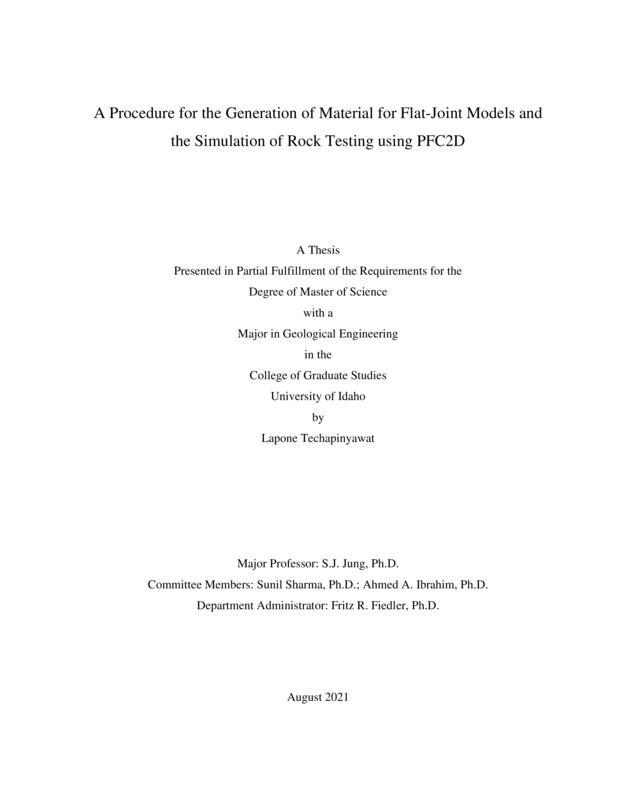A Procedure for the Generation of Material for Flat-Joint Models and the Simulation of Rock Testing using PFC2D
Techapinyawat, Lapone. (2021-08). A Procedure for the Generation of Material for Flat-Joint Models and the Simulation of Rock Testing using PFC2D. Theses and Dissertations Collection, University of Idaho Library Digital Collections. https://www.lib.uidaho.edu/digital/etd/items/techapinyawat_idaho_0089n_12184.html
- Title:
- A Procedure for the Generation of Material for Flat-Joint Models and the Simulation of Rock Testing using PFC2D
- Author:
- Techapinyawat, Lapone
- Date:
- 2021-08
- Keywords:
- Bond parameters DEM Discrete elements Macro properties PFC2D Simulation
- Program:
- Civil Engineering
- Subject Category:
- Geological engineering
- Abstract:
-
The overall behavior of rock mass is effectively controlled by the micro properties of its constituent particles and the bonds between the particles. Unfortunately, the micro-scale properties are difficult to measure with routine laboratory tests. This study, using Discrete Element Methods (DEM), investigated the influence of these micro-scale bonding properties on typical parameters which may be measured in a uniaxial compression test.
This research used the DEM software: “PFC2D” (Itasca 2019) to investigate the influence of the micro-scale bond properties. PFC2D is a popular DEM simulation program that can be used to study the behavior of rock made up of discrete particles. It creates discontinuous bodies, balls, clusters, and clumps in the model and bonds them together as a rigid body. However, the material properties to be assigned in the model are bond properties, and not typical material properties. “Inverse modeling" is used to essentially back-calculate appropriate bond properties that will match laboratory material properties. Calibrating the material without studying the consequence of assigning bond parameters is not practical. So, this research provided a parametric study of four bond parameters: (1) normal to shear stress ratio (kratio), (2) tensile strength (fj_ten), (3) effective modulus (emod), and (4) cohesion (fj_coh). The parameter labels, such as kratio, correspond to the names defined for use in PFC2D. These selected parameters were varied for a total of 108 uniaxial compressive and 108 direct tension simulations to see which parameters should be adjusted and calibrated first to match lab tests.
The recommended procedure for generating material for flat-joint models starts with adjusting the four bond parameters in the following preferred order: (1) kratio to match the material's, Poisson's ratio, (2) fj_ten to match the material's tensile strength, (3) emod to match the material's Young's modulus, and (4) fj_coh to match the material's compressive strength.
This procedure was found to be most effective because the last parameter's calibration does not affect the previously calibrated parameters. The bond's friction angle was assumed to equal the material's friction angle for all cases.
Because the calibrated, simulated material behaves identically to the real specimen, the development of cracks during loading was also studied. Interestingly, the study demonstrates that the material cracks in a small portion of the linear elastic zone before entering the nonlinear zone.
Additionally, we discovered that the inclusion of rock lineations, with different properties, resulted in a range of compressive strength, Young's modulus, and ultimate axial strain, depending on the angles. The compressive strength, Young's modulus, and axial strain of materials with lineation acting at a 30-degree angle to the maximum principal stress produced the lowest values.
- Description:
- masters, M.S., Civil Engineering -- University of Idaho - College of Graduate Studies, 2021-08
- Major Professor:
- Jung, S.J.
- Committee:
- Sharma, Sunil; Ibrahim, Ahmed A.
- Defense Date:
- 2021-08
- Identifier:
- Techapinyawat_idaho_0089N_12184
- Type:
- Text
- Format Original:
- Format:
- application/pdf
- Rights:
- In Copyright - Educational Use Permitted. For more information, please contact University of Idaho Library Special Collections and Archives Department at libspec@uidaho.edu.
- Standardized Rights:
- http://rightsstatements.org/vocab/InC-EDU/1.0/

